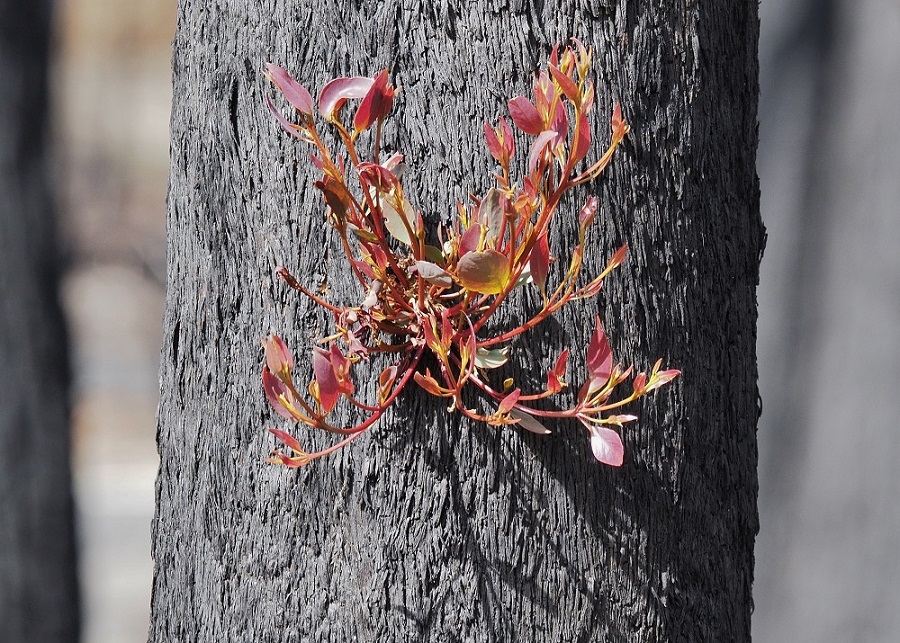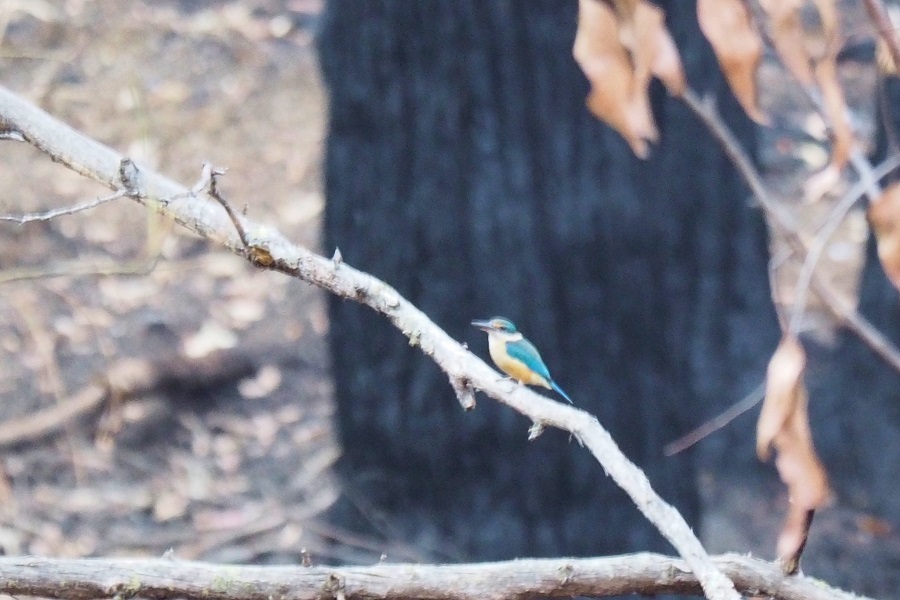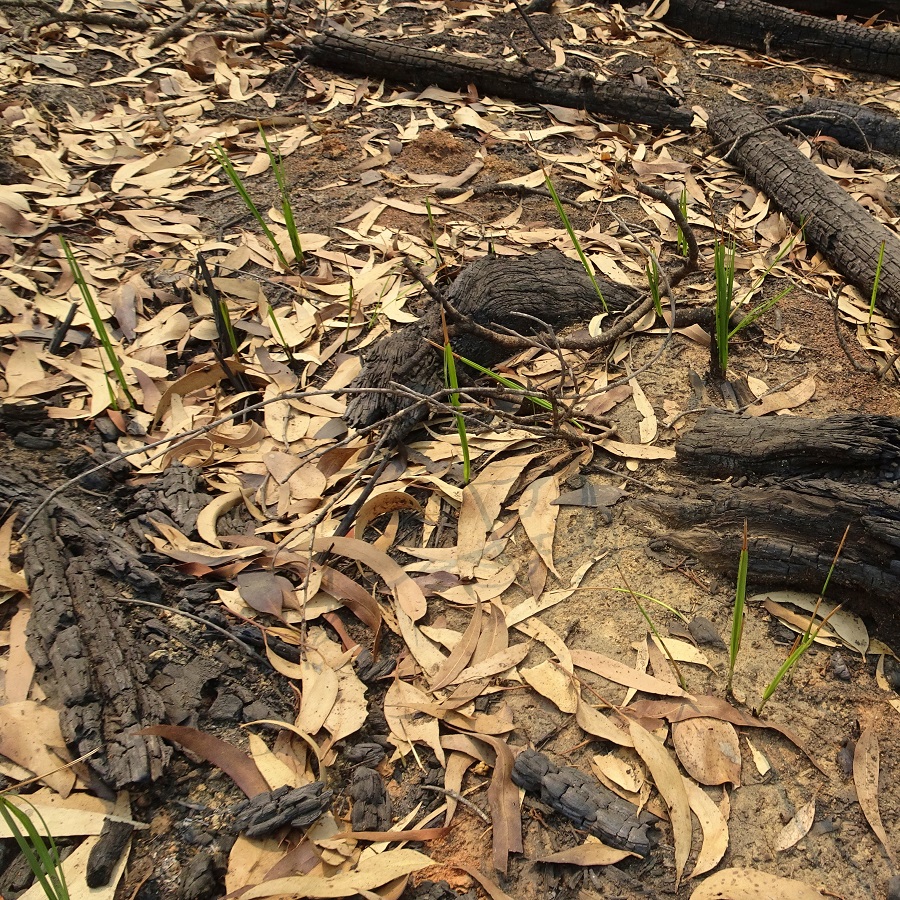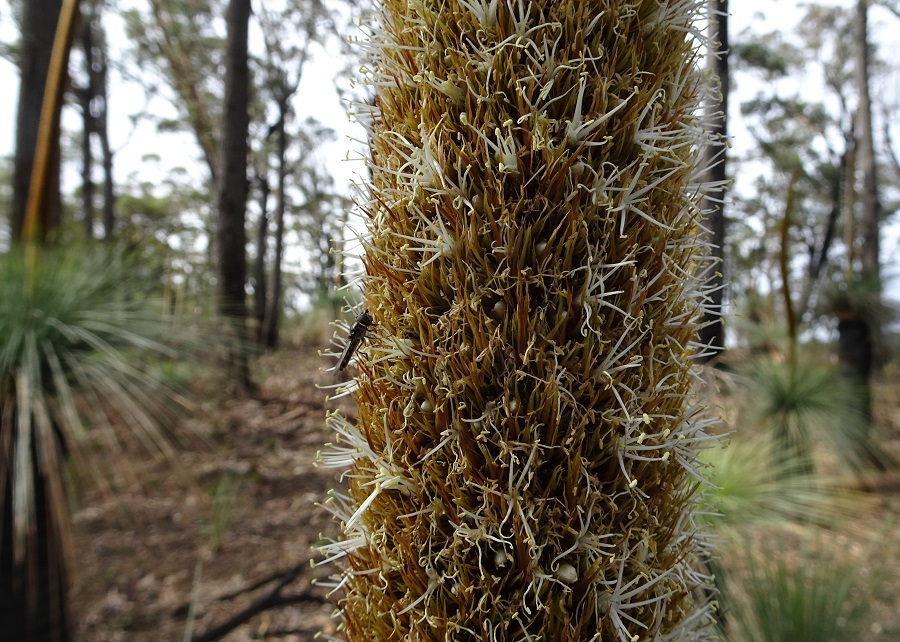Nature’s recovery from fire in East Gippsland - the first 6-8 months
In the midst of a far reaching multi-year drought, the summer of 2019-20 saw bushfires sweep across large swathes of East Gippsland and the extent of the fire affected areas was and still is, hard to comprehend. It is easy to see the changes to our wonderful natural areas as devastation – it looks so bare and nothing like the beauty that we are used to. We are acutely aware of the loss of wildlife and wonder if the stark landscape will ever recover. We know that it will though and while places won’t look the same for a long long time (or maybe never be the same again), they are still a functioning ecosystems and a reminder that nothing stays the same in nature. Watching over the past 6-8 months, we wanted to share some of the tricks nature has up its sleeve to make the best of this new situation. I would like to share some images of the first 6-8 months, mostly fairly close to Bruthen as that has been the most sensible due to COVID-19. Explorations further afield will come later.
Monitoring and recording the changes after bushfire
As soon as I could safely do so, I found a few places that were burnt and not far away, to establish three sites to record regeneration using photos and conduct regular bird surveys submitted to Birdata and later record wildlife including invertebrates (using iNaturalist to help with identification). Since then I have also visited and recorded data at other sites, but it was a privilege to get really early post burn photos at these. These first three sites vary both in the date they were burnt and the intensity of the burn. The following two images show changes at a very intensely burnt site taken 5 months apart.
Above photo was taken 3 weeks post fire, and below 6 months post fire at the same point.
During the first few weeks, despite the stark blackened look, close investigation shows that some plants respond almost immediately after being burnt. This is what provides some critical food supply for any wildlife that have survived the fire. For herbivorous mammals like wombats or wallabies, the greenery that emerges in those critical early stages may not be their preferred food, but it will stop them from starving. Plants like bracken fern that are not very palatable still provide critical cover for small fire survivors to help them hide from predators.

Above: Three weeks post fire the Xanthorrhoea minor on the left and rushes on the right have about 8cm of growth already.

Above: Bracken Fern has grown quickly in sandy soil at Sarsfield and only 2 weeks post-fire it is providing critical ground cover and refuge for small wildlife (Photo: Peter Lawrence)
Most people know how eucalypts send out shoots after fire, but do you know how this occurs? One of their clever adaptations is to have epicormic buds beneath the bark on the trunk and branches (or in the lignotuber at the base of some species) that are protected from fire by the bark. The growth of these buds is supressed by a chemical or hormone inhibitor produced in the leaves (crown) during normal photosynthesis. Once the tree’s leaves are burnt, it can no long photosynthesise, so no inhibitor is produced and the epicormic buds start to shoot. Even though as time goes on many of these lower epicormic shoots will drop off, they serve the purpose of giving the tree the initial ability to grow again and provide food and shelter for wildlife before the crown of leaves re-establishes.

Above: Epicormic shoots on a burnt Eucalytpus tree start off pink coloured (left), but soon turn green (right)
It is hard to imagine how any animals survive fire, but somehow, some do. An important factor for them is patchiness within the fire area. Fire intensity and burn patterns are not ubiquitous, they vary across the landscape. Damper gullies can slow the fire and some patches that are skipped over by fire initially, even though they may burn later, provide initial refuge, then animals can move away from the second run of flames into already blackened areas. Some animals have limited ability to flee and take shelter where they can – deep rock cervices or deep tree hollows can be helpful for small creatures and the burrows every wombat digs (they always have a few “holiday houses” on the go) make a perfect fire shelter for any small creatures who can fit inside. Lyrebirds are well known to take shelter from fire in wombat burrows. Even so, we know this summer, the bush was so dry and the fires so extensive that many many animals will not have survived, so it is lovely to see evidence of survivors. In far East Gippsland as part of the Southern Ark project, remote cameras have shown a range of wildlife active within days of the fire front passing through.

Above left: A Black Wallaby fire survivor peeps through the trees Above Right: a Wombat has left a characteristic square shaped dropping or scat on a burnt log.
As well as larger mammals, small invertebrates need to re-establish post fire and they are really important at the bottom of the food chain. Even very early post fire visits revealed grasshoppers and butterflies, tiny spiders hiding in the leaves, a range of flies and similar insects as well as ever present ants. As time passes more and more invertebrates are being seen and they in turn will provide food for things like lizards, birds and some of the possums. Back in our Autumn update blog we had a photo of a Yellow-bellied Water Skink that survived the fire and would have been seeking small invertebrates like these to eat while making sure it did not end up as someone else’s lunch itself.


Left: A Meadow Argus butterfly, Junonia villida Middle: The mound built by ants around their hole Right: Tiny orange Orb-weaving spider hiding in a leaf

Above: A very hungry caterpillar muching through new Eucalypt leaves and Hoverflies (Common Halfband) on a flowering Cats-ear Daisy that has emerged after the fires.
There have been copious numbers of “sap-sucking bugs” that feed on the sap from the eucalyptus stem. Some leafhoppers produce a by-product called Honeydew and others like Psyllids produce sugary secretions which they use to create a “lerp” which is a little tent over themselves to protect them from predators. As well as these insects providing food for insectivorous birds, the sugary lerps are prized by many bird species with a sweet-tooth. As mentioned in a lovely article by Land for Wildlife, “Lerp is a highly valued resource in the Australian environment. It is eaten by flying foxes, possums, gliders and a variety of birds such as pardalotes, honeyeaters, friarbirds, whistlers, silvereyes and thornbills. Some birds such as pardalotes, weebills and small honeyeaters virtually live off lerps in some seasons.” So the appearance of psyllids and their lerps in great number on the epicormic shoots is a providing a great stepping stone in the food chain.

Above left: A tiny pink Psyllid, and Right, a host of different winged Psyllids and their wingless larvae, showing the white sugary excretions which are becoming the protective Lerp coverings. All of these are making good use of the new growth of epicormic growth on Eucalytus trees post fire.
Eating and avoiding being eaten… that is what life is all about for most wildlife. When you think of predators, you probably think of the carnivorous mammals, but even small “sweet” little creatures can be predators. In the images below Superb Blue Wrens were happily picking insects off leaves of a fallen tree. I was so delighted to see a Sacred Kingfisher at one of the burnt survey sites on day. Then it swooped to the ground and flew to a branch with a lizard in its beak – and down the hatch went the lizard…. It had survived the fire, but in the end became food for another fire survivor. The reality of the “circle of life” in nature.

Above left: Sacred Kingfisher after catching a lizard in burnt forest Above Right: superb Fairy Wren foraging in a fallen burnt tree.
What about the smaller plants? As well as growing from seed, many plants have the ability to grow again from the roots of the burnt plant. This even applies to grasses and rushes, but equally to shrubs. Plants with more than one method of regeneration after fire or disturbance have a massive advantage over something that is a “obligate seeder” (ie: the adult is always fire killed completely and the next generation has to grow from seed). In Australia some plants make use of fire to crack open hard seed pods to release the seeds en-mass, but majority of species of plant can resprout somehow as well as grow from seed – doubling their chances of survival as a species.

Left: Grass Tree Xanthorrhoea australis quickly grew a new skirt of leaves on the blackened trunks. Right: Narrow-leaf Geebung Persoonia linearis also resprouted leaves from the base of the burnt trunk

Above: The Black She-oak, Allocasuarina littoralis is a critical food tree for the endangered Glossy Black Cockatoo, so luckily they are equiped with two options after fire. The fire opens their seed pods to release seeds, but some burnt trees also re-sprout from the base.

Above: The Tree Hakea Hakea eriantha on the left makes use of fire to pop open additional seed pods to release the seeds and on the Right, this Sunshine Wattle, Acacia terminalis could either have grown from seed or sprouted from the roots of the burnt plant.
Flowers are appearing, especially on plants that have the ability to germinate quickly from tubers or roots but also where plants were and only lightly impacted by fire, maybe on the edge of a gravel road. Nectar seeking insects and in some instances small birds like Eastern Spinebills will be attracted to the flowers as they appear.

Left: Bright pink blooms on Common Heath Epacris impressa, found unburnt on a roadside. Right: Tiny Greenhood, Pterostylis parviflora has emerged quickly post fire from the underground tuber

Left: Hairy Fan Flower Scaevola ramosissima. Right: Flower spikes on a large trunked Grass Tree, Xanthorrhoea australis was attracting many nectar feeding insects
Aquatic wildlife has struggled post fire as rainfall washes ash and silt into creeks and rivers. There is an interesting video about the rescue of various aquatic wildlife post fire at this link- Aquatic Rescue It is just one of the many Biodiversity recovery projects going on. Our beautiful Tambo River turned to a river of mud after heavy rain in February, but it is lovely to see it flowing a lot clearer now.

Left: Tambo River in February was flowing with thick mud and fire debris Right: Tambo River in July was flowing much clearer again
Finally there are fungi. Given that we have had lovely winter rain this year, its been a great year for fungi and they are appearing on burnt ground and on burnt stumps and logs. Fungi have their own role to play as decomposers and some are relished as food by Wombats and invertebrates. In far East Gippsland the Endangered Long-footed Potoroo is a truffle eater, digging for the underground treats!

Above left: A bright white Jelly fungi on a burnt log Above Right: A cluster of pretty Laccaria sp. fungi growing on burnt ground
I hope you have enjoyed learning a bit more about nature’s recovery after fire. The natural environment is constantly changing but fire causes change much faster than other natural processes. Especially where fire is too frequent or very large in scale it can cause problems with the fine balances in nature. There are lots of concerns about the ability of some fire sensitive ecosystems to return to full functionality again as well as the risk of extinctions at individual species level. The knowledge that climate change is going to drive increased fire in the landscape in the future makes it even more concerning. We will watch our survey sites with interest over the coming months and years and share observations again with you later. Hopefully too we can get out and explore more of our regular tour destinations further east and bring you stories from there too.
Above: When some Eucalyptus species get only lightly burnt, they later shed the singed layer of bark, often it has beautiful colours and patterns
Our Blog page is a good way for us to keep up the connections with nature for you while we cannot share nature with you in person on tours. We might have been in lockdown, but nature never closes – so keep looking when you are outdoors, observing, appreciating and maybe some learning as well.
Jenny Lawrence 13.8.20
Go to - Previous story Tiny Wildlife in East Gippsland during Autumn
Go to - Blog index page
If you would like to leave a comment about this story you can do so on the post about it on our Facebook page and like the page to be notified when the next Blog story is published.
PO Box 69, Bruthen, Victoria 3885 AUSTRALIA
Email: This email address is being protected from spambots. You need JavaScript enabled to view it.
Phone: (03) 5157 5556 (International +61 3 5157 5556)
www.gippslandhighcountrytours.com.au


















